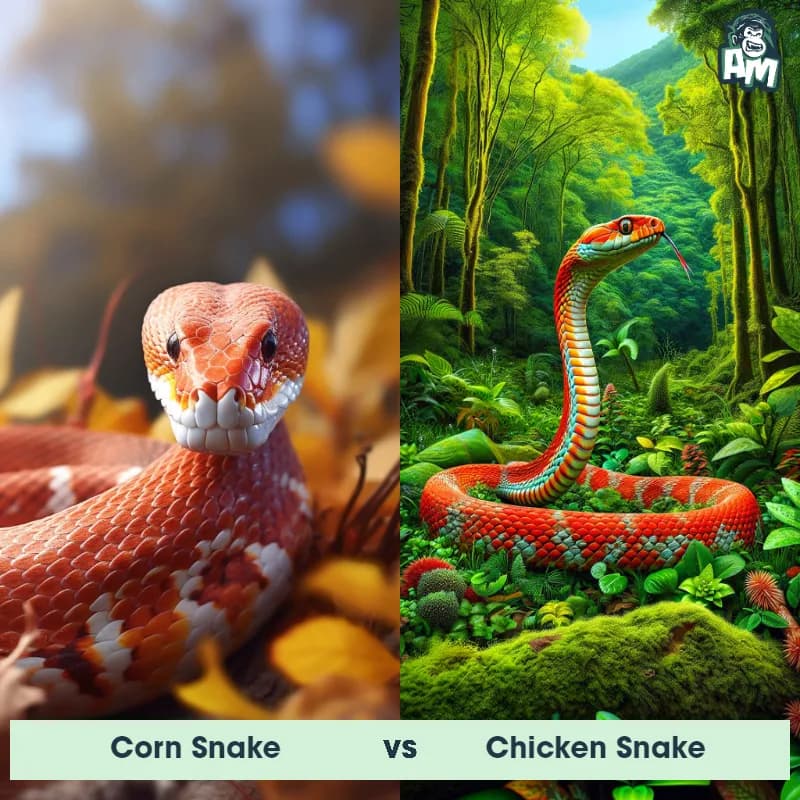Corn Snake vs Chicken SnakeSee Who Wins

Ladies and gentlemen, welcome to this extraordinary animal matchup! Today, we have a thrilling battle ahead between two slithering competitors. In the red corner, weighing in at an impressive 2 pounds, we have the agile Corn Snake. And in the blue corner, at an equally formidable weight of 2.5 pounds, we have the sly Chicken Snake. It's time to witness the ultimate reptilian showdown!
Contender 1: Corn Snake
The Corn Snake, also known as the red rat snake, is a non-venomous species of snake that is native to North America. They are slender and can grow up to 6 feet in length, with a distinctive pattern of orange, brown, and black scales. Corn snakes are known for their docile nature and are popular pets among snake enthusiasts. They are also excellent climbers and can be found in a variety of habitats, including forests, fields, and rocky areas.
Fun Fact: Corn snakes are excellent escape artists and can squeeze through small openings, such as gaps in cages or loose vents, making it important for owners to secure their enclosures properly.
Contender 2: Chicken Snake
The Chicken Snake, also known as the Eastern Rat Snake, is a non-venomous colubrid snake found in North America. It is a slender snake with smooth scales and can grow to be quite long, reaching lengths of up to 6 feet. The snake is typically black or dark brown with a white or yellow belly, and it has a series of black spots running down its back. It is an excellent climber and often found in trees, as well as on the ground, and it preys on small mammals and birds.
![[object Object] Gif](https://tenor.com/view/viralhog-egg-snake-hungry-gimme-that-gif-12840403.gif)
Fun Fact: The Chicken Snake is known for its ability to climb trees and even walls using its strong and flexible body, making it a skilled arboreal predator.
Matchup Stats
| Corn Snake | Chicken Snake | |
|---|---|---|
| Size | Up to 6 feet (1.8 meters) | Up to 6 feet (1.8 meters) |
| Weight | Up to 2.5 pounds (1.1 kilograms) | Up to 3 pounds (1.4 kilograms) |
| Speed | Speed: 5 mph (8 km/hr) | 8-12mph (13-19km/h) |
| Key Strength | Constricting ability | Agility and climbing skills |
| Biggest Weakness | Lack of venom | Lack of venom |
Current Votes
Corn Snake vs Chicken Snake
See Who Wins
View More Matches
Looking For More?
Similar Matches
Scientific Stats
| Corn Snake | Chicken Snake | |
|---|---|---|
| Scientific Name | Pantherophis guttatus | Pantherophis alleghaniensis |
| Family | Colubridae | Colubridae |
| Habitat | Forests, fields, rocky areas | Forests, woodlands, and fields |
| Geography | North America | North America |
| Diet | Rodents, birds, small animals | Small mammals and birds |
| Lifespan | 6 years - 20 years | 5 years - 10 years |
Key Differences between Corn Snake and Chicken Snake
- Scalation: Corn Snakes have smooth scales on their bodies, giving them a sleek appearance. Conversely, Chicken Snakes have keeled scales, resulting in a rougher texture on their skin.
- Habitat Preference: Corn Snakes are primarily found in the southeastern United States, inhabiting diverse habitats such as forests, fields, and marshes. Chicken Snakes have a wider range, occupying various habitats across North America, including woodlands, farmlands, and suburban areas.
- Coloration and Pattern: Corn Snakes exhibit a wide range of vibrant colors and patterns, including bright reds, oranges, yellows, and browns, often with distinct black markings. In contrast, the Chicken Snake has a more subdued coloration, typically featuring shades of brown or gray with dark stripes or blotches running down its body.
- Size: The Corn Snake typically grows to be smaller, with adults reaching lengths between 3 to 5 feet, while the Chicken Snake can grow significantly larger, commonly reaching lengths of 6 to 7 feet.
- Eye Pupil Shape: Corn Snakes possess round pupils, similar to that of humans, whereas Chicken Snakes have elliptical-shaped pupils, which are more characteristic of reptiles.
- Head Shape: The Corn Snake has a relatively slender and elongated head shape compared to the Chicken Snake, which has a slightly broader and more rounded head.
































